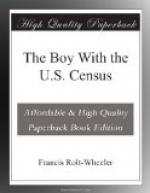“But do you really mean to say,” queried Hamilton in surprise, “that every one of these fifty or more parts of each gun is inspected and tested?”
The official led him to a number of long rows of tables.
“Here,” he said, “are girls doing nothing else all day long. Here is a testing die for a part of the ejector of one of our 1911 models. You see that there are two spaces for all of them. It must fit into this one, it must not fit into that, which is a thousandth of an inch smaller. If too big, you see it won’t fit into either, if too small, it would fit into the one where it ought not. Every tiny piece is gauged on all its sides and in every hole and at all points with this double gauge system.”
“That doesn’t leave much for guesswork,” said Hamilton. “But there is something that’s been puzzling me.”
“What is that?” asked his guide.
“I’ve always heard a lot about gun-metal,” Hamilton answered, “and yet all the way through, these parts have been nothing but steel. And all the guns I ever saw had that bluish look, as gun-metal has. For example, my watch is what they call gun-metal,” and he took it from his pocket and showed the back of it.
“Gun-metal,” said the other, “is an alloy of copper and tin and once was used almost exclusively for cannon and big guns generally. But you’re right about all guns having a bluish tinge. That is all steel, but it is treated by a process called coloring or bluing. I’ll show you—both the old way and the new.”
Going down the stairs and crossing the yard, he took Hamilton into a small building where there were a couple of open charcoal furnaces, in which the charcoal was intensely hot, but not hot enough to catch fire. The pieces of finished steel were buried in this charcoal, and every few minutes the men in charge would draw them out, wipe them over with a bunch of oiled waste, and thrust them back into the fire. It was about the dirtiest, blackest, grimiest work the boy had ever seen.
“That is the old way,” Hamilton was told, “and although it is handwork instead of machine work it is not a bit better in its results than the new way. The modern system, besides, is much simpler and cleaner.”
In the next building was a row of charcoal ovens, revolving in such a way that the parts to be blued were alternately covered and released from the superheated charcoal, the effect of the greasing also being done at every automatic revolution Each furnace door bore an asbestos clock.
“What are those clocks for?” asked Hamilton. “The same as those others, I suppose, so that the man in charge can put in a number of certain parts of a gun and leave them in for a regular length of time at a certain heat, and pull them out all done?”
“Just that,” was the reply. “The only gain in the old style is that each part being handled separately, if there is ever so little difference in the metal, the bluer can give it a shorter or a longer time, whereas the machine treats all alike.”




